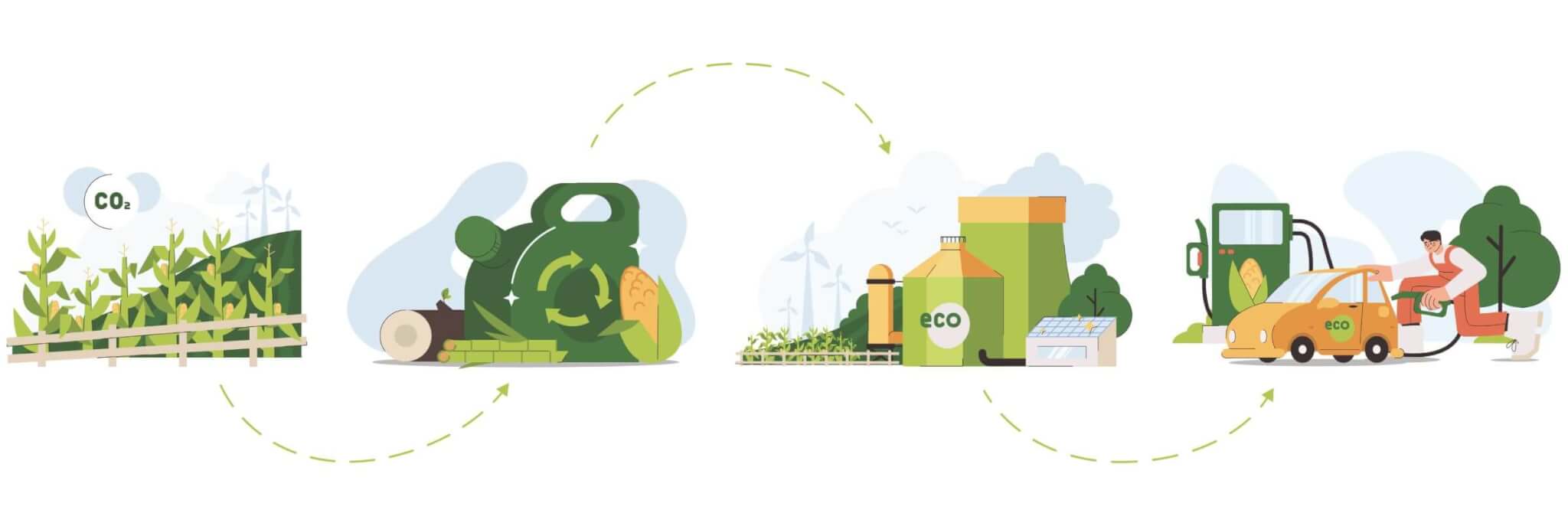Biodiesel is an alternative fuel source that many construction companies are considering using regularly to improve their carbon footprint. This fuel source is carbon neutral and ultimately positively impacts not just the environment but also safety, energy resilience, and engine operation. Biodiesel offers a more sustainable method of powering engines and a safer alternative in the event of petroleum spills.
Quick look
- The construction industry contributes more global emissions than any other industry, and steel, concrete, and aluminum are the top contributing materials.
- Biodiesel is a carbon-neutral fuel source made from plant oil, feedstock, animal fat, and other renewable sources.
- Biodiesel is safer, more energy resilient, and better for your engine compared to petroleum fuel.
- Not every engine can handle a biodiesel blend, so check with your original manufacturer to avoid potential engine damage.
Construction’s cost to the environment
The construction and building materials industry accounts for 37% of global emissions, and is the largest contributor of greenhouse gases by a wide margin. The manufacturing and use of steel, cement, and aluminum come with a large carbon footprint, and historically much of the industry’s progress has focused on lowering operational carbon emissions.
Operation emissions come not from the materials themselves, but from cooling, lighting, and heating. According to projections, reducing these emissions will decrease the sector’s total emissions from 50 to 75% over the coming decades. However, the fuel used to power manufacturing equipment and transport materials also significantly contributes to environmental damage.
The materials impacting the environment most

Outside of operational emissions, the building materials themselves greatly impact the environment. The materials most commonly used that are the worst for the environment include:
- Concrete: Concrete is a major contributor to global emissions and pollution. Each pound of concrete releases 0.93 pounds of CO2, and it is the second most used product on Earth after water.
- Steel: Steel production emits large quantities of nitrogen oxides, which harm bodies of water and soil biodiversity.
- Aluminum: While it is an abundant material, mining aluminum uses significant energy, causing a large carbon footprint. To produce one ton of aluminum, it takes 15MWh of electricity, which is enough to power a two-person home for 5 years.
- Asphalt shingles: These shingles are commonly used and can contaminate water supplies. They also take hundreds of years to decompose.
What is biodiesel?
Biodiesel is a renewable substitute for diesel fuel made from renewable materials. Used in standard diesel engines, this alternative fuel uses materials like:
- Waste cooking oil
- Algae and fish oil
- Animal fats like sheep and beef tallow, poultry fat, and pork lard
- Plant oils such as camelina, canola, flax, soy, mahua, jatropha, pinnata, pongamia, coconut, palm, hemp, mustard, and sunflower.
Although less common, biodiesel is also sometimes made with cellulosic feedstock made from forest biomass.
How is biodiesel made?
Feedstock is made of fatty acid methyl esters (FAME) through transesterification. This process creates a reaction between animal fat and oil, using a catalyst and an alcohol.
The chemical reaction then produces two materials: glycerol and the ester called biodiesel. Vegetable or other plant oils that have not undergone this transesterification process are not yet considered biodiesel and should not be used in an engine.
The benefits of biodiesel
In the context of the construction industry, biodiesel blends could be used in machinery like cranes, front loaders, bulldozers, and the transport vehicles between projects. This greatly reduces the industry’s carbon footprint and creates a greener project output.
Biodiesel is widely considered a viable solution to reduce carbon pollution due to it being a renewable fuel source derived from plants. This means that when burned, it releases approximately the same amount of CO2 as was absorbed by the plants during their growth.
This effectively creates a carbon-neutral cycle and greatly lowers total greenhouse gas emissions compared to traditional petroleum diesel.
Safety
In its unblended, pure form, biodiesel causes much less damage and safety risk than petroleum diesel because it’s far less combustible. Biodiesel has a flashpoint higher than 130°C, while petroleum diesel’s flashpoint is only 52°C. If released or spilled, biodiesel poses far less risk to those in the area and is safer to store, transport, and handle. The construction industry is known for high rates of injury and fatality and safer on-site materials solutions are becoming more sought after.
Balance and energy resilience
By using biodiesel over petroleum diesel, the construction and transportation industries are provided with diverse, clean transportation options. This strengthens national energy security by reducing reliance on traditional fuel when emergencies and natural disasters occur by overcoming fuel supply disruptions.
Biodiesel could be used as either a complete substitute or a means of extending supplies of traditional diesel. The transportation and construction industries account for over 30% of U.S. energy needs and roughly 70% of petroleum consumption. If biodiesel is used for even a small fraction of the transportation needs in these industries it can offset the reliance on traditional fuel.
Engine operating
Biodiesel is better for the environment but also for your engine. Diesel engines require lubrication for their parts to prevent premature wear and damage. Using biodiesel improves lubricity and increases the cetane number of your fuel.
The U.S. federal regulations have established reduced allowable fuel sulfur to only 15ppm and decreased allowable aromatics content. This has reduced the lubricity of traditional diesel. Even at very low levels, biodiesel can raise the lubricity and improve your engine’s lifespan. Even 2% biodiesel is enough lubricity to make a difference in engine maintenance.
The environment
A successful transition to a cleaner construction and transportation industry will mean various fuel and vehicle solutions to lower life cycle emissions. Using an alternative fuel like biodiesel reduces these emissions because the CO2 released from the biodiesel during combustion is effectively offset by the CO2 absorbed from the feedstocks, plants, or soybeans used for biodiesel production.
Can you use biodiesel in your vehicle’s diesel engine?
Yes—for vehicles manufactured after 1993, diesel engines can use biodiesel, including fuel injection equipment, with little impact on engine performance. However, if your vehicle was made before 1993, including heavy equipment, the engine could have been made with incompatible parts, and it might break down with repeated biodiesel use.
Original equipment manufacturers (OEMs) typically approve biodiesel blends up to B5 in their vehicles, with some approving up to B20 or more. However, some manufacturers don’t recommend a blend higher than B5 for highway use in vehicles made in 2007 or later. Under some conditions, high levels of biodiesel may build up in the engine lubricant of these models.
It’s unknown whether these higher blends might affect lubricant performance, so it’s best to check your OEM’s website or contact a dealer to determine the right blend for your vehicle. On the job site, check with your heavy equipment provider for the type of biodiesel blend best suited for your machinery.
Bottom line
Making an impactful change to the global carbon issue is manyfold. Still, by standardizing the use of alternative fuels like biodiesel, we can improve road safety, energy resilience, engine operation, and the environment. These benefits apply both on and off the construction site.
Plant oils, animal fats, and even waste cooking oils can be used to create biodiesel, and regular use could partially offset the impacts of destructive building materials like concrete and aluminum. It starts with one blend at a time.
Subscribe to the newsletter and follow us on social media to stay in the loop about advancements in the construction industry.


